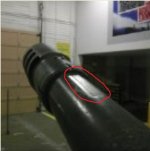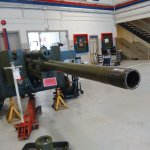GR66 said:
Two of the consistent topics in this thread seem to be that the 105's we have aren't serviceable and that the Reservists aren't trained adequately for the M777s.
It would seem obvious that a replacement for the C3's/LG1's is required, but I'm curious about the focus on training the Reserves on the M777. We only have 37 of the 155's and we have 3 x Regular Artillery Regiments. Is our manning so low on these Regiments that we can't manage to man 37 x guns with the gunners we have? Or is there another issue causing the problem?
Is having a large pool of Reservists trained on the M777 a realistic priority or is there some wishful thinking going on that we will magically get more guns if/when we ever have to deploy a real military force?
To my novice mind it would be highly unlikely that Canada could realistically deploy and sustain more than a Brigade Group in a near-peer conflict. If that's the case then what would a realistic and affordable Artillery force for Canada look like?
You raise some interesting questions and put forward some practical answers which I think are what I call "band-aid" solutions to a critical problem.
The highlited words are very much the issue. For all intents and purposes we have three brigades (and a div headquarters) and a special operations force. Strong, Secure and Engaged (SSE) does not posit a need to ever deploy a brigade group but only battle groups of various sizes and duration. While we do have three brigade groups, they are woefully short of elements needed to give them a role in a "near peer" conflict. Adequate artillery, mortars, air defence, anti armour defence are just the more obvious shortfalls. Having a brigade with two LAV battalions and a light battalion is another (it's just a convenient way of distributing the LAVs - if we really were thinking of deploying a brigade, we'd form one light brigade and two medium brigades.)
Do I think that SSE is correct. Hell, no. SSE talks about offering a credible deterrent to "near peer" adversaries but then structures a force that is anything but credible. Quite frankly I'm not sure whether our defense structure is based on SSE's limited objectives or whether the objectives are limited because we've created a structure that's incapable of doing more than that. It's a bit chicken and eggish. Either way, our military leadership has a documented authority from the government that limits its requirements to deploy nothing more formidable than a battle group.
GR66 said:
Hypothetically would it make sense to build toward something like this:
- 1 x Regular Artillery Regiment equipped with the M777's with 4 x 6 Gun Batteries with the remaining 13 x Guns for training and replacements.
- The other 2 x Reg Force Artillery Regiments get equipped with LAV-based 120mm Mortar vehicles. The Reg Force Gunners in these two Regiments would also be cross-trained on the M777.
- The 19 x Reserve Regiments each get issued 1 x Towed 120mm Mortar
The M777 equipped Regiment would in effect act as a Divisional Artillery asset for the Army and could focus on deep strike and counter-battery missions.
One LAV-120mm Mortar Regiment would be the integral Artillery Regiment to the Brigade Group giving the BG mounted indirect fire support that can keep up with the BG and the Infantry Battalions would have their 81mm Mortar Platoons for intimate indirect fire support.
There is a practical and seductive reasoning in your solution but, just because M777s are the largest guns we have, they do not make a div arty resource. Just because it's easier to buy and man 120mm mortars does not mean they should become the brigades close support regiment. Guns and mortars are complimentary for several reasons and neither one or the other should be abandoned because of cost considerations. If you look at what we jokingly call "near peers" (but in reality are our superiors in all ways), you will see that every one of those organizations has a mix of guns and mortars in support of a brigade (A US SBCT [the nearest equivalent to our LAVIII brigade] with three Stryker bns (each bn with 10 x 120mm mortars [30 total] as well as 6 x 60mm and 6 x 81mm in a "swap out wps locker concept) and integral 105mm mobile gun systems direct fire vehicles) has 18 x M777s, while a Russian restructured motorized rifle brigade with three infantry battalions (24 x 120 mm mortars total) and one tank battalion has two battalions of self propelled (36 x 152 mm), 1 x bn MLRS (18 x 122mm and up launchers), 1 x anti-tank bn (6 x 100mm guns and 12 x ATGM), and an antiair battalion with a variety of weapons.
Both the US and Russia consider their brigades as deployable, self contained entities but part of a modular force that can add resources for smaller campaigns or deploy as part of divisional organizations with additional artillery brigades to beef up the support.
GR66 said:
In case of a major conflict the 3rd Reg Force (LAV-120mm Mortar Equipped) Regiment could with refresher training provide individual replacements for the M777 regiment and their LAV-120mm Mortar vehicles could replace losses in the BG Regiment. Individual augmentees for the BG LAV-120mm regiment could come from the Reserve Regiments (training on their own towed 120mm mortars).
In wartime the Reg Force recruits could focus on M777 training at the Artillery School while recruits to the Reserve units could focus on training Gunners on mortars. If required, the Reserve Regiments could group together to generate 3 x 6-tube 120mm mortar batteries to deploy.
I don't want to seem cynical, but in the event of war time with a "near peer", we are screwed because we are cobbling things together. If we were truly intent on supplying one brigade to a "real peer" war, then we should form one fully equipped LAV brigade with three LAV and one tank battalion, with each battalion having 6-8 x 120mm mortars (preferably in a mortar carrier vehicle) an 18 x M777 regiment. (that still leaves us short proper anti-armor and anti-air). We could probably also have one light brigade supported by another 18 x M777 regiment and a mix of 81/120 mm mortars and a stock of personnel and weapon systems for battle loss replacement but along the way we would need to ditch the third brigade because we just can't properly equip or man it. Quite frankly, I think we could do much better than that if we relied more on a largely reserve force manned and equipped medium to heavy force. Based on our current authorization of around 21,000 reservists (and an ideal size of 29,000) we should be capable manning between 4 and 6 manoeuvre or support brigades if properly organized, trained and equipped. There are numerous reasons why we can't right now but this just has to change. We are missing out on a tremendous opportunity.
Where reservists and regulars fit in the establishment and training program is up for grabs. I don't object to artillerymen running mortars (the Russians do and the US has a separate MOS for mortar infantrymen) I just think it's better that they be infantrymen because that way they are more versatile within the battalion (I also see nothing wrong with converting reserve artillery regiments to Infantry mortar platoons if we want to give them 120mms)
Personally I would like to see a seriously revamped reserve system which would be able to provide both individuals and units/subunits for the deployable force because there are substantial cost savings in using reservists to man organizations that are designated for extreme situations. In my mind a the "medium" brigade(s) should have many reservists while the "light" brigade(s) and special forces would be almost entirely regular force because they are much more likely to be used on the day-to-day operations currently envisioned in the SSE.
GR66 said:
From what I understand 120mm mortars are cheaper to acquire and have a smaller logistical footprint than 105mm guns and LAV-based 120mm mortar vehicles already exist so this solution would be less costly than many other options.
Personally I'd much rather see the Artillery branch equipped with HIMARS and M109's or even the mounted 105's that have been mentioned, but with the major expenses coming to rebuild the RCN and the RCAF I don't see that being possible. Something like the above however would at least provide the Canadian Army with a credible and useful indirect fire capability that could be developed at a reasonable cost.
My inexperienced :2c: worth anyway.
I too think that there is a role for reserve artillery with HIMARS and we could certainly use that capability within the brigade (the Russians certainly do and the US has numerous National Guard HIMARS battalions/brigades as well as M109 NG battalions and brigades. (maybe we shouldn't have cut up for scrap all the ones we had - which in my mind, still constitutes professional negligence within the leadership of the army and branch.)
Unfortunately with SSE there is little vision to deploy HIMARS with a battle group. And as I said before, the actual confronting of a "near peer" adversary is just smoke and mirrors with perhaps a very limited deployment within a multinational brigade. I think we are saddled with a leadership that is too "civil service" centric, has a high level of risk aversion and is not prepared to face the reality of fighting a superior foe.
:2c:
:cheers:
 ) speaking to same media.
) speaking to same media.


